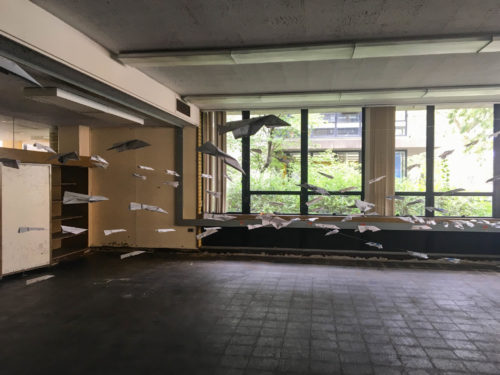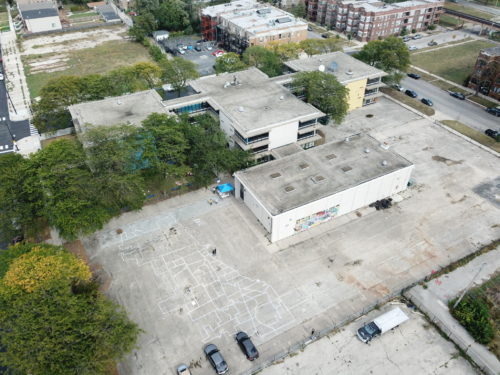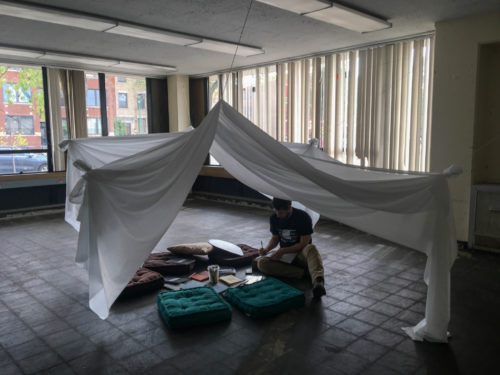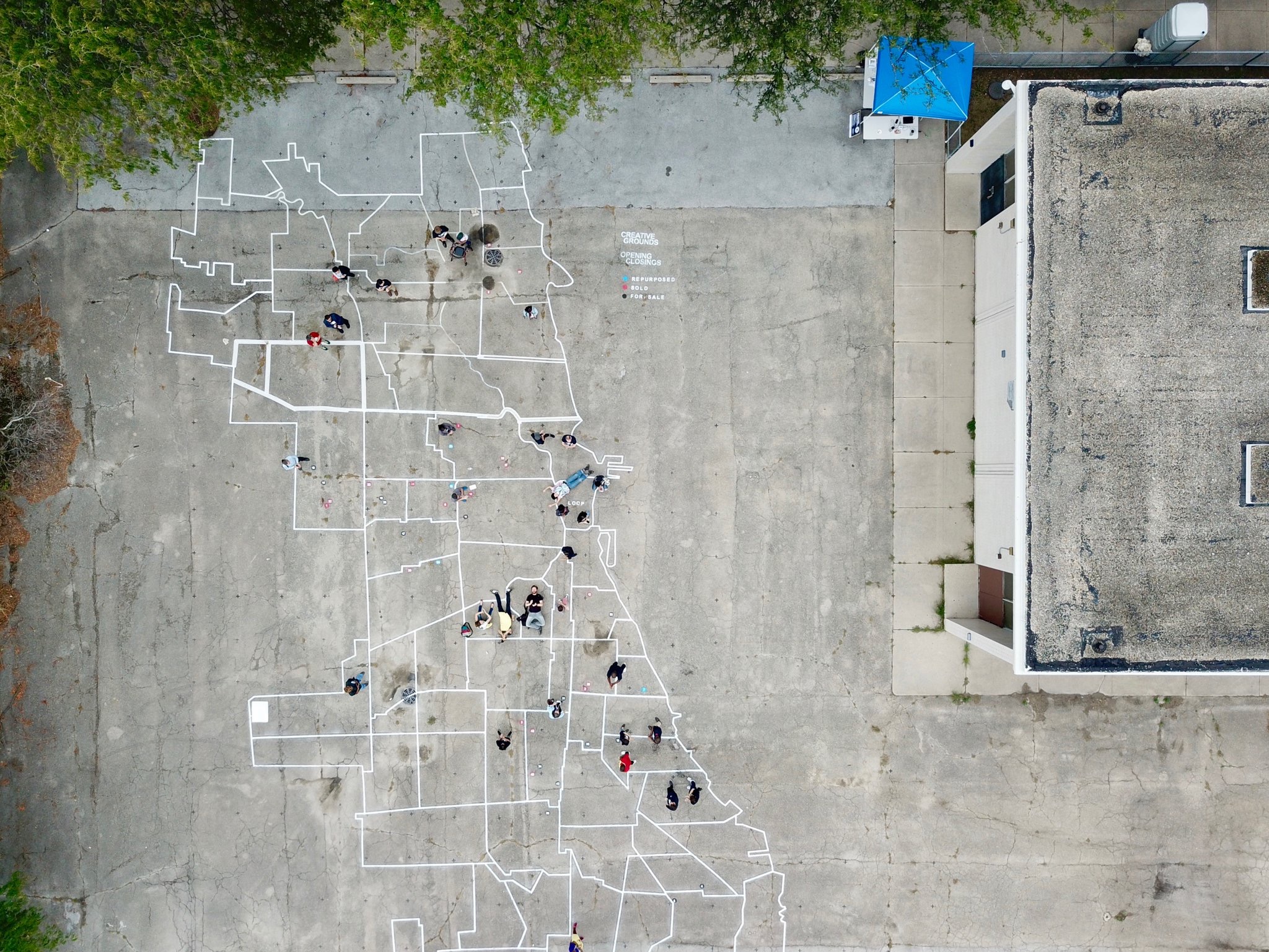Over four years after the school closed, on Saturday afternoon, October 7, the Overton Elementary building temporarily reopened to the public for Opening Closings: Reactivating Closed Chicago Public Schools.
Anthony Overton Elementary School was one of the fifty Chicago Public Schools (CPS) closed in 2013, at the time one of the biggest school closings in one district anywhere in the country. The school has been sold to developer Ghian Foreman, but to many Bronzeville residents, its future purpose remains unclear. Opening Closings is part of Creative Grounds, an initiative from urban design firm Borderless Studio to create dialogues around plans for repurposing closed Chicago Schools. The event was funded by a grant from the Chicago Architecture Biennial. DOCOMOMO-US Chicago, the local chapter of the committee for the documentation and conservation of the modern movement, and Chicago Arts Partnerships in Education partnered with Creative Grounds for this event.

“This a way to keep the buildings active, not necessarily each day, but maybe on some occasions,” said Paola Aguirre, the founder of Borderless Studio. She views this event as a way to bring in community members and create visibility around plans to repurpose CPS’s many closed buildings. According to the Chicago Reporter, seventeen of the forty-three buildings closed in 2013 remain unsold as of late September. Twenty-one schools have been sold, and five have been repurposed by CPS or another public agency, but as with Overton Elementary, not all the sold schools have a definite plan for repurposing. And, ever since CPS placed vacant schools on the open market in January this year, the reuse of school buildings could receive even less scrutiny from local communities.
“If that’s the future of over forty schools in Chicago, let’s all pay attention to it and let’s talk about it and get involved,” Aguirre said.
Both Aguirre and other organizers talked about the event as part of keeping school buildings public spaces once they’re sold or repurposed. “This resource was once public and should retain that public use, by very virtue of the fact that our public tax dollars funded this structure,” said Daniel Ronan, who works with DOCOMOMO-US Chicago.
Throughout the afternoon, visitors could walk through Overton Elementary School, looking both at the building as it awaits remodeling and at art installations created by students from Daniel Hale Williams Preparatory School of Medicine, which is only a five-minute walk away. Outside, in the school’s parking lot, organizers painted a large map of Chicago with all of the closed schools and their current status. Inside, organizers gave guided tours, where they informed visitors about the history of the building, the current plans for its remodeling, and the building’s architectural significance.

Designed by Chicago architecture firm Perkins and Will, Overton Elementary opened in 1963 and was planned to coincide with the opening of the Robert Taylor Homes to serve its residents and other nearby students. The building adheres to a modernist style, with large windows in the classrooms and hallways and thick black steel bars on the exterior of the building. Overton was “built to serve children from underserved neighborhoods,” and was the last of three postwar prototypes for modernist schools built by local architects.
The school was named after Anthony Overton, the first African American to lead a major business conglomerate, establishing several businesses in home goods, realty, and life insurance. When the school was closed, its student population was ninety-two percent Black and ninety-five percent low-income.
Walking through the building felt eerie at times. The school’s history seemed to haunt the building: cabinets where you could imagine children hanging their backpacks and coats stood half open and empty, classrooms once full of desks and colorful posters were stripped bare, and the floors, which were probably once childproof linoleum, had been pulled up to leave concrete covered in old black glue.
But also throughout the building were musings of what the space could be. On the whiteboards and blackboards in the classrooms, organizers asked visitors to write their ideas of how Overton could be repurposed. Responses ranged from turning the school into a nighttime art gallery, to an indoor agriculture space, to simply a place for the community to thrive.
Organizers and student artwork from Williams Prep also asked visitors to engage with the idea and purpose of public education itself with art installations and more questions on chalkboards. One student art installation invited visitors into a tent made from a sheet to sit on cushions and journal about their experience with school. Another featured paper airplanes made from old, recycled worksheets hung from the ceiling of a classroom.

Williams Prep students’ ideas about potential uses for the building filled what used to be Overton’s lunchroom. With their teachers, the students had spent a year drawing and modeling their plans for what the school could become. The students, many of whom lived near Overton, imagined turning the space into everything from a pediatric center to a dance studio to a health foods store.
The developer who owns the building, Ghian Foreman, plans to turn it into a business incubator called Anthony Overton Entrepreneurship Center. Although he originally planned to turn the building into a set of Live Work apartments—residences that individuals can operate a business out of—he said that the finances didn’t work out.
“I went back to the drawing board and said, ‘What does our community need?’” Foreman said after the event. “Where’s that lawyer, that accountant, that guy who doesn’t need an office but just needs a desk. We don’t have Starbucks in our neighborhood, so somewhere that he could work.”
He added that he wanted the space to continue Bronzeville’s history of black entrepreneurship, one rooted in Anthony Overton’s own legacy, calling the neighborhood “Black entrepreneurship central.”
Despite all of the discussion around how Overton can be repurposed and reimagined for the community, several Bronzeville residents argued for returning the building to its original purpose. For residents formerly connected with the school, the building’s closing is still a source of pain, over four years later. On one of the blackboards, a visitor wrote that the building should to be reopened as a school.
Irene Robinson, a resident whose six children and several of her grandchildren attended Overton, called the school closures a “hate crime.”
“It’s a disgrace that we’re here right now, that we’re looking at a school that children should be coming to Monday,” she said. “This was our second home. It was more than just a school, the school is more than just a building, it’s a heart. Coming here today, it’s heartbreaking to know that I’m not coming here to know that they’re going to open it back up for the children.”
“I’m disheartened that whoever bought this building didn’t realize the history of the families, the teachers, and the communities of students that they kicked out,” said Jeanette Taylor. Her children attended Mollison Elementary School, where many of the students from Overton now go, and she served on Mollison’s Local School Council.
“It’s classic, let’s push low-income and working families out and make it brand new for the incoming gentry,” she added. “So it’s gentrification on steroids and a disrespect to real community folks’ voice.”
Linda Thomas, who taught at Overton for twenty years and now teaches at Mollison, said that she wanted answers from the event but had not yet gotten them. “It’s been sitting, standing for [four] years and nothing has been said.”
Repurposing plans at other closed schools have stalled because of similar anger about the closings from the communities around them. Foreman responded to these desires from the community by saying that the neighborhood around Overton had neither the population to support the school nor the funds for costly maintenance to the school compliant with the Americans with Disabilities Act, to remove asbestos, and to repair windows.
“I want to invite them to come on back and invite them to be part of the solution,” he said. “Let’s all come together and make this community better.”
With Opening Closings over and Overton now closed again, Aguirre wants to replicate Opening Closings at other closed schools in the city.
“My whole argument is that you cannot treat these places as a business as usual,” she said. “Let’s have a right process, a true and right process that people can connect to so that they can understand why these things have to close and how we can redevelop them all together.”
Support community journalism by donating to South Side Weekly

